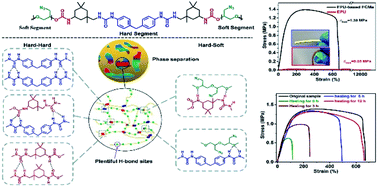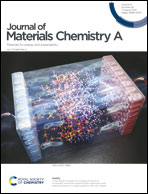Parthenocissus-inspired, strongly adhesive, efficiently self-healing polymers for energetic adhesive applications†
Abstract
Energetic self-healing adhesives have a positive effect on the energy level, mechanical properties, and microcrack healing performance of energetic composite materials (ECMs). However, it is very challenging to design and synthesize energetic self-healing adhesives with high healing efficiencies and satisfactory mechanical properties. Herein, this study introduced a new design strategy. Plentiful dynamic hydrogen bonds endow the adhesive with high-efficiency self-healing performance, and inspired by Parthenocissus, strong adhesion gives ECMs good mechanical properties. The basic characteristics of this design included: (1) loose hard domains; (2) rapid rearrangement of the hydrogen bonds; and (3) strong interfacial adhesion. The synthetic energetic adhesive polyglycidyl azide (GAP)–isophorone diisocyanate (IDI)–4,4′-methylenedianiline (MDA) completely recovered all mechanical properties within 2 h after breaking at room temperature. Simultaneously, the enthalpy of formation of 1.95 kJ g−1 indicated that the adhesive possesses a good energy level. Significantly, ECMs containing explosive crystal 1,3,5-triamino-2,4,6-trinitrobenzene (TATB) and our designed energetic self-healing adhesive exhibited good mechanical properties and surprising crack-healing capabilities. In addition, compared with non-energetic adhesive-based ECMs, energetic adhesive-based ECMs exhibited excellent combustion properties. Therefore, the GAP–IDI–MDA adhesive demonstrated strong application potential and this strategy is expected to provide new ideas for the improvement of weapon system security.



 Please wait while we load your content...
Please wait while we load your content...